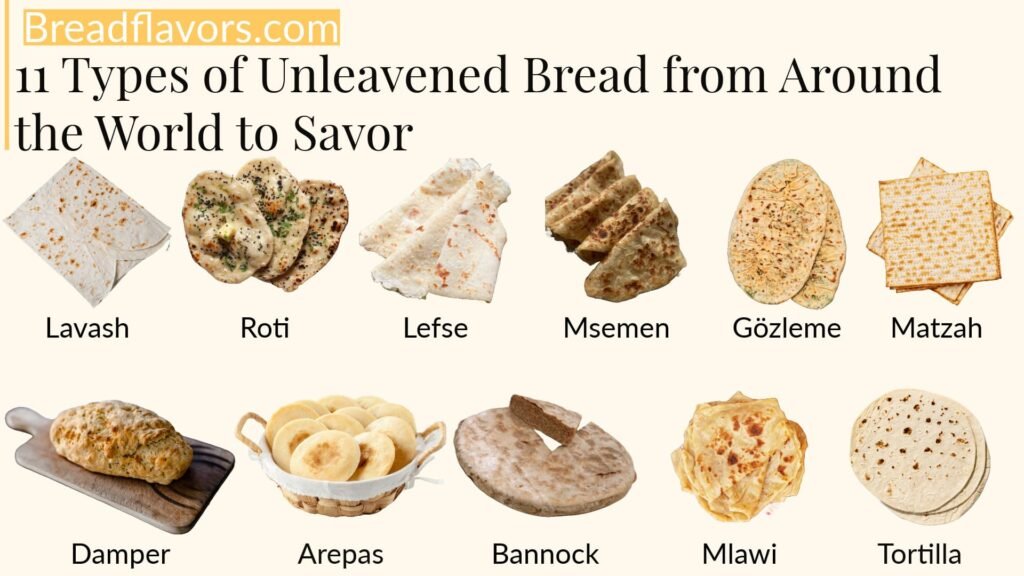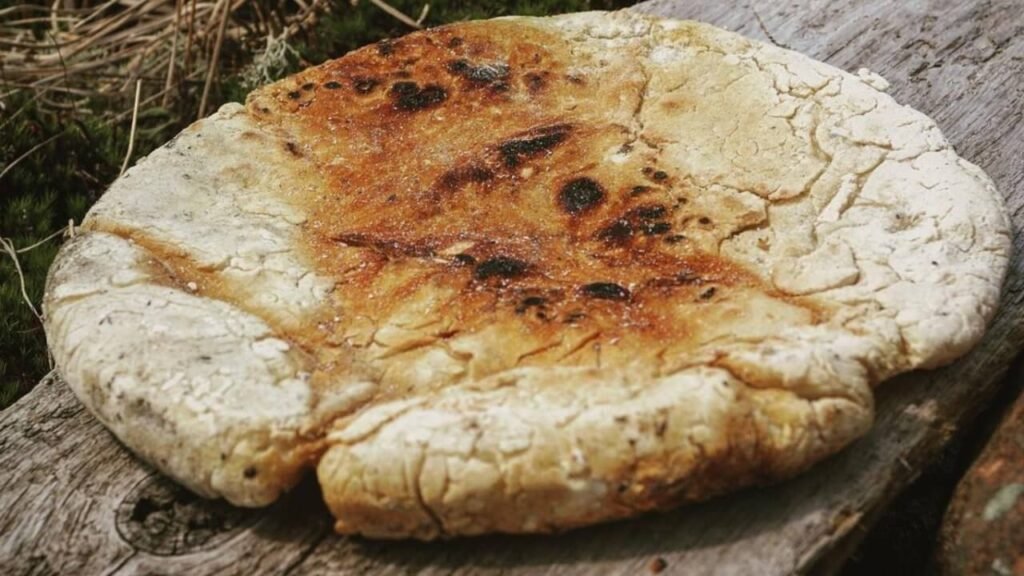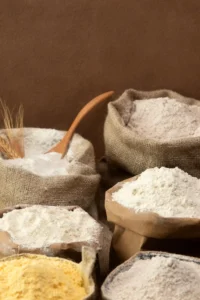
Unleavened bread represents a culinary tradition that has been a staple around the world since the Neolithic period. Typically made from wheat flour and water, without leavening agents. Its simplicity belies its versatility, making it suitable for various occasions as well as symbolic significance in common religions including Christianity and Judaism. From Lavash and Tunisian Mlawi to Roti and Jewish Matzah. There are different example of unleavened bread that reflect the rich traditions of the regions they come from. Whether you’re curious about the meaning of unleavened bread or want to try your hand at making some yourself. This article provides an informative and inspiring journey through the different types of unleavened bread.
Unleavened Bread Meaning
Unleavened bread are a types of flat breads made without rising agents, such as yeast and baking powder, which are commonly used to help bread to rise. As a result, most examples of unleavened bread are usually flatter and denser than other types of bread, with a unique texture that can range from soft and pliable to crisp and cracker-like. Its simplicity lies in the basic ingredients used, which usually include water, a type of flour, and sometimes salt and some grains. Though unleavened bread recipes can vary depending on the regional traditions. They have played an important role in various cultures and religions for thousands of years, symbolizing everything from humility and purity to practicality and flexibility.
Releted: 7 things to know about Unleavened Bread
List of Types of Unleavened Bread

Matzah
Matzah, also known as Matzo, is a traditional Jewish flatbread especially eaten during Passover, the seven-day Feast of Unleavened Bread, and it can be found as part of every meal in the Jewish home during this period, where it plays a symbolic the humility and haste of the Israelites departure from the land of Egypt, as mentioned in exodus 12.
Matzah is usually made with simple ingredients including flour and water, with some varieties including a touch of salt or oil. The dough is rolled thinly, perforated to prevent rising, and then baked at high temperatures to achieve its signature crisp texture. Today, you can find modern matzah types including whole wheat matzah and egg matzah that are often paired with haroset or sweet toppings like chocolate, honey and nut creams.

Damper
Damper is a classic Australian bushman bread, according to Wikipedia, it’s originally made by cattle herders who needed sustenance on their long journeys. The dough is made from wheat flour, salt and water, and traditionally baked by placing it directly on campfire ashes until it sounds hollow when tapped, resulting in a dense, chewy texture. Today, Damper is one of the iconic symbols of bush life in Australia and can be found in bakeries where the recipe has been adapted to be prepared in a variety of ways, including additions such as milk and butter. Make it ideal for perfect with savory spread, or top with jam, honey or golden syrup.

Bannock
Traditional Scottish round, flat, unleavened bread, and commonly used in other parts of the United Kingdom. Derives its name from the Latin “Panicium,” meaning anything baked: bread, baked goods and cake. Traditionally, Bannock is made with flour, water, salt and sometimes butter, then baked on a Bannock stone.
Bannock comes in many varieties and have been enjoyed during religious holidays and festivals such as Beltane and Lammas Bannock. It held superstitions, like stirring it batter in a specific way to avoid bad luck. Over time, bannocks became a staple of Scottish cuisine, where they were enjoyed as part of soups, with fillings such as butter and jam, or simply on their own.

Roti
Also known as Phulka, Rumali or Chapati depending on the Indian culture and region. Made from atta “whole wheat flour” and water, though some variations may include salt or oil. After mixing, the dough is shaped into small balls, rolled out into thin rounds, and baked on a hot griddle called Tava, resulting in a soft, pliable unleavened bread perfect for eating on its own or as a ladle for curry. Nowadays, roti is a preferred choice for everyday use as it can be served as a side dish for a variety of Indian dishes, including: Suran Sabzi, Gobi Curry, and Kofta Curry with cabbage.

Mlawi
Mlawi is an unleavened Tunisian flatbread, made from simple ingredients like semolina flour, oil, water and a touch of salt. After kneading, the dough rests briefly before being flattened and folded by hand using olive oil, forming layers that are baked to a crispy and soft texture on tagine, a traditional Tunisian griddle. Result in an oiled bread with a slightly crispy exterior and soft, chewy interior, perfect for wrapping in sandwiches or on its own. Mlawi is often found on nearly every street corner, loved by people of all ages, wrapped in spicy Tunisian fillings like harissa or grilled salad or with sweet toppings like chocolate, honey or butter.

Arepas
A popular Latin bread, especially in Colombian and Venezuelan cuisine, where each country brings its own twist to this cornbread. Arepas are culturally significant throughout Latin America, representing the dexterity of indigenous communities who were the first to cultivate corn as a staple crop, which is its main ingredient along with water and salt. The dough is shaped into small round cakes, then grilled until the crust is golden and slightly crisp, but these characteristics may vary from region to region. Traditionally, arepas can be filled or served alongside like Sopa de Mondongo, offering endless serving options.

Tortilla
The foundation of Mexican cuisine for thousands of years and a popular bread in the southwestern of US, dating back to ancient Mesoamerican civilizations, it holds a deep cultural significance, as Maize and Aztec was a sacred crop for the Aztecs and Mayans. Tortilla is typically made from masa harina or wheat flour, lard or oil, and baked on a hot griddle, resulting in a bread with a soft, pliable texture and neutral sweet flavor. Perfect for various Mexican dishes including Tacos, Quesadillas and burritos.

Lefse
A traditional Norwegian flatbread, traditionally made from a dough that typically includes riced potatoes, milk, lard or butter, and wheat flour, then baked on a flat, large griddle, resulting in a soft texture with a mild, earthy flavor. In addition to its popular flavor: sugar and butter Lefse. There are many other lefse flavors, such as cinnamon and lingonberries lefse, ham and egg lefse, and butter and corn syrup lefse, as well as savory varieties with mustard or seafood. Traditionally, lefse was baked at home, but today it can be found in most supermarkets around the Nordic countries, and in some United States cities with high percentages of Norwegian ancestry, such as Minnesota, North Dakota, and Seattle.

Msemen
Msemen is a traditional Moroccan square soft unleavened bread, much like Tunisia’s Mlawi, but often made from a blend of flour, semolina, salt, yeast, water, and oil or butter. The dough is kneaded until smooth, then divided and allowed to rest before it’s carefully stretched and folded into a square shape with a sprinkle of semolina and butter before being cooked on a hot griddle until golden and crisp, resulting in a lightly crisp, buttery bread. Msemen is usually eaten on its own or with tea at breakfast, but it also goes well with spreads like honey, butter, cheese, or jam.

Gözleme
Anatolian unleavened white bread is a popular Turkish street food made from flour, water, and salt that is typically stuffed with mashed potatoes, cheese, and parsley before being served with a cup of tea or ayran. Gözleme can be found all over Turkey, where if you get the chance to visit Turkey. You may see women rolling the Gözleme dough with a wooden board and cooking it on a large griddle. Making it one of the most beloved street foods by tourists ahead of locals,where it can be enjoyed at any meal from breakfast to quick daytime snack.

Lavash
One of the oldest types of bread in the world and the foundation of the Caucasian and West Asian cuisines, especially Armenian and Iranian cuisines. Its cultural importance was recognized by UNESCO in 2014, and it remains integral to various rituals and celebrations. Lavash is traditionally made from wheat flour and water then baked in a tandoor, which gives it a chewy texture with dark spots. Commonly served with local cheese, meats and local vegetables, as well as placed on newlywed’s shoulders as a symbol of prosperity.
Conclusion
With its variety and cultural richness, Unleavened bread are a meaningful way to enjoy traditional flavors from all over the world. From the hearty Scottish bannock to the versatile Latin arepa. Each type of bread brings a unique taste and story to the table, and showcases how a few basic bread ingredients can create a delicious staple. Ready to make your own, grab some flour, water and a pinch of salt, and start with this easy unleavened bread recipe at home.




